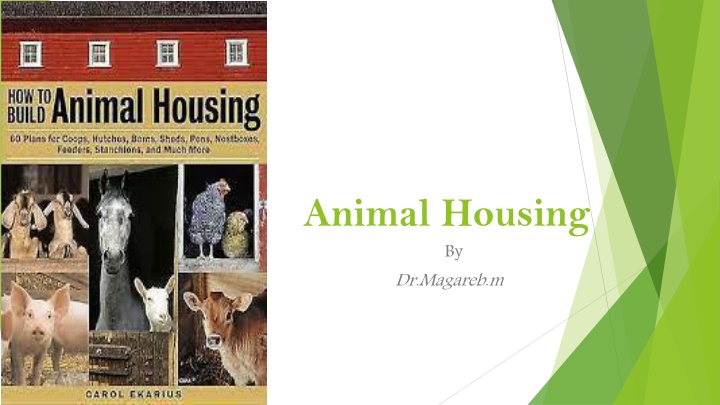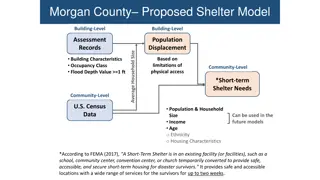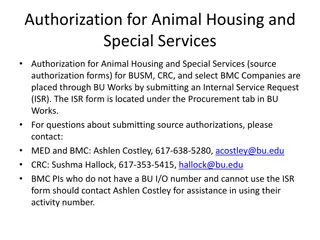
Animal Housing: Shelter and Construction Considerations
Animal housing provides shelter for animals to protect them from various weather conditions and ensure their well-being. Understanding the factors influencing construction is crucial for creating suitable living environments. Considerations include physiological traits, sanitary conditions, and production strategies. Site selection, building design, and construction methods play key roles in providing safe and comfortable housing for animals.
Uploaded on | 2 Views
Download Presentation

Please find below an Image/Link to download the presentation.
The content on the website is provided AS IS for your information and personal use only. It may not be sold, licensed, or shared on other websites without obtaining consent from the author. If you encounter any issues during the download, it is possible that the publisher has removed the file from their server.
You are allowed to download the files provided on this website for personal or commercial use, subject to the condition that they are used lawfully. All files are the property of their respective owners.
The content on the website is provided AS IS for your information and personal use only. It may not be sold, licensed, or shared on other websites without obtaining consent from the author.
E N D
Presentation Transcript
Animal Housing By Dr.Magareb.m
Animal housing They are areas where animals seek shelter to protect themselves from the effects of changing weather such from heat in the summer, cold and rain in the winter, to keep them safe from insects and dangerous animals, and to provide a comfortable environment for them, especially after they return from grazing or work, to make their care and feeding easier .. Most farm animals require some form of protection from the elements. Most people believe that the most crucial time to give shelter is during the winter, however an animal's natural coat allows them to withstand far colder temperatures than humans. Summer heat is significantly more difficult on animals than winter heat if they do not have access to shade, whether from trees or structures on grassland, or from a lack of ventilation in a barn or building
When constructing a building, there are a few things to consider. 1-The animal's physiological traits, as well as the extent to which meteorological elements influence the animal's nature, health, andproductivity 2-Improving sanitary conditions so that when creating structures, the ease of fighting infections and avoiding their spread is considered, as well as the convenience of cleaning and disinfecting them
production strategy Identifying the project's goal, the type of animal production, the invested capital, project requirements, building materials, and other tools Site selection 1-It should be near a shopping center or major city, but not near residential areas . 2-To limit disease transmission between farms, the distance between farms should be two kilometers . . 3-Being close to major roads will make it easier to get supplies to the farm 4-Being close to food and livestock markets 5-It should be kept dry and well ventilated
a building design When designing structures, simplicity and low cost are considered, as well as several factors that must be considered 1-kind of animal 2-animals' numbers 3-define the design style (open or close) 4-the amount of space required for all animals 5-building directions. 6-close to farmland
Construction 1-A concrete floor that is deeper and thicker than the width of the wall on which it is erected is required when constructing buildings . . 2-To keep moisture out of the foundation, one centimeter of asphalt is applied 3-After constructing brick or limestone walls to improve warmth in the winter and cooling in the summer, the thickness of the wall must not be less than (33 cm) and the height must not exceed three and a half meters to ensure ventilation Cement must be applied to the inside as well as the outside of the walls 4 - . 5-Walls can be paved with faience or painted to be smooth and easy to clean from the inside at a height of (2-1.5 m), while the rest of the wall is painted with lime and dusted with cement from the outside . 6-The walls must be kept dry at all times since moisture encourages bacteria and fungi to thrive in the housing, resulting in an offensive odor
Roofing Roof Red tiles Concrete Wood (sheep) Open Central Roof Close On Side
Windows 1-Windows provide ventilation and lighting in a home, and their area should not be less than (1:20-15:1) of the total floor space to suit both needs . 2-Height (2.5-2) meters above the ground level of the dwelling to protect the animal from air currents 3-It must open inward and have joints on the bottom (Sheringham system) . 4-Air currents should not arise if they are placed opposite each other 5-It must be covered with a net to keep flies and other hazardous insects out of the house, particularly the milking area
Flooring . . 1-The floor must be durable, wear-resistant, and long-lasting 2- It's dry, impervious, and has the quality of not seeping water into the building 3-It should not be smooth to prevent the animals from slipping. The floor could be dirt, sand, or cement .
dirt floor the groundIt is used to store manure beneath the animal, where it is covered with a layer of earth and so on whenever it gets wet until it rises to the surface, at which point it is carried to the fields for fertilizer. Cement floor This floor is made of cement and is inclined by 1% towards the back of the animal, where a gutter canal transports urine and washing water out of the builing. A rough surface is covered with a straw substance that is 15-30 cm high.
Doors Barn doors must be wide, ranging from (2-2.5) m, open outward or by sliding, and not have sharp protrusions that could injure animals if they come into touch or clash with them when entering or exiting. The base of the doors must also be robust.
a requirement for animal protection 1-Avoid direct contact with animals to prevent the spread of respiratory infections. 2-Disinfection of the premises with disinfectants 3-Isolation of suspected animals in the southern half of the field 4-excellent ventilation 5-Regular cleaning of the premises and disposal of manure and garbage in appropriate areas






















